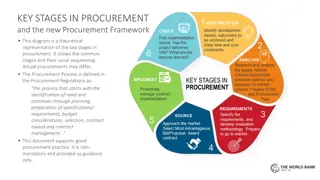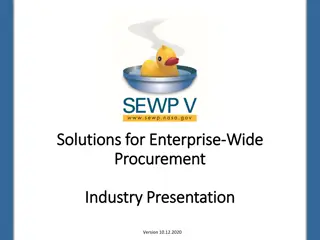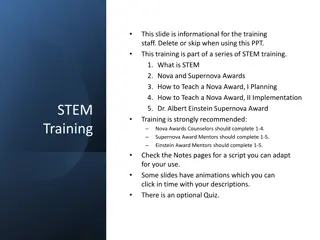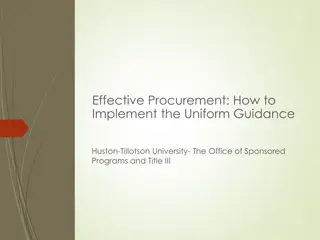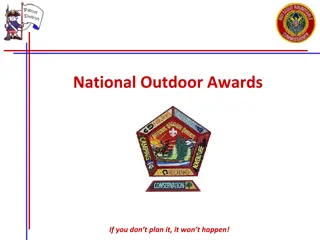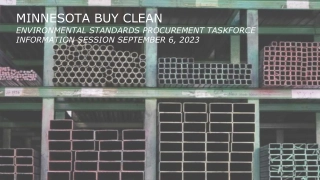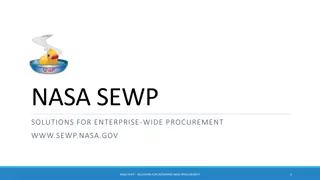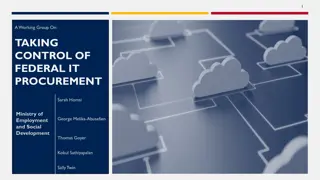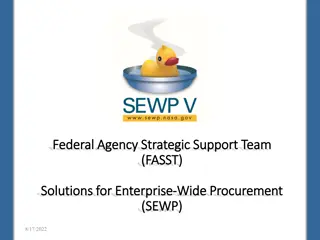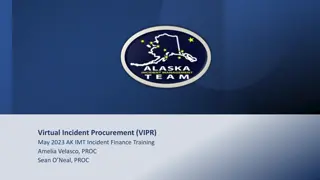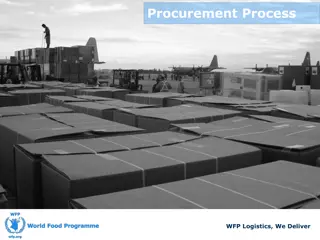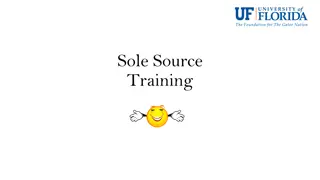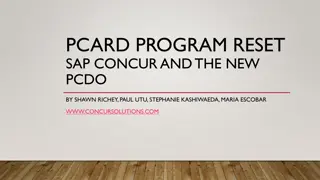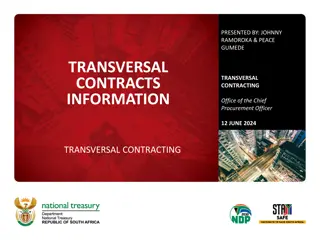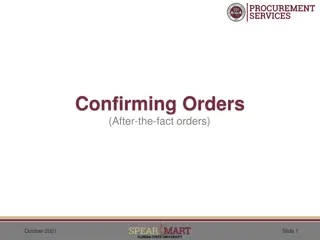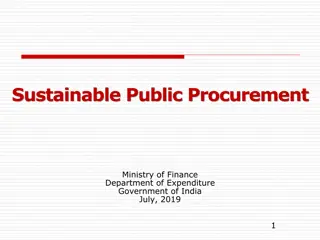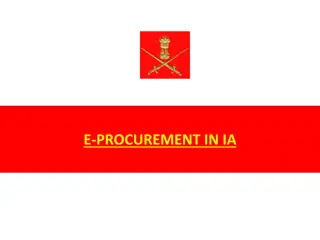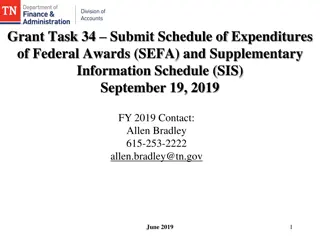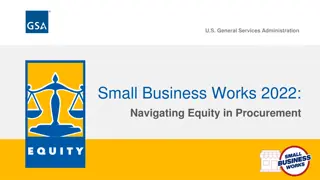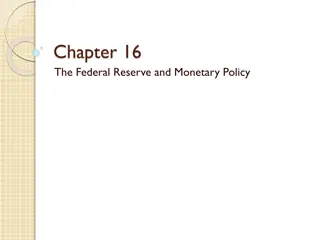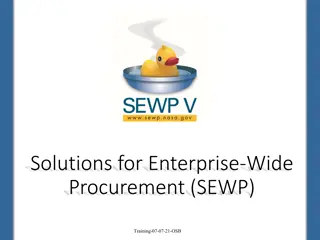Understanding Federal Awards Procurement Standards
Explore the Uniform Rules-Federal Awards Procurement Standards under 2 C.F.R., addressing common federal findings, state versus non-federal entities, and state compliance requirements. The information provided delves into the purpose of procurement standards and the importance of adhering to federal requirements to avoid disallowed costs. It emphasizes the need to go beyond seeking the lowest price and consider broader objectives in procurement decisions.
Download Presentation

Please find below an Image/Link to download the presentation.
The content on the website is provided AS IS for your information and personal use only. It may not be sold, licensed, or shared on other websites without obtaining consent from the author. Download presentation by click this link. If you encounter any issues during the download, it is possible that the publisher has removed the file from their server.
E N D
Presentation Transcript
Uniform RulesFederal Awards General Procurement Standards Rod Fortin Director of Local Gov t Assistance Department of Legislative Audit 300 S. Sycamore Avenue, Suite 102 Sioux Falls, SD 57110-1323 ph. (605) 367-5810 rod.fortin@state.sd.us DLA website: www.legislativeaudit.sd.gov 1
https://www.ecfr.gov/cgi-bin/text-idx?SID=e024f4f13b656d4a1f1124f615af2ad3&mc=true&tpl=/ecfrbrowse/Title02/2cfr200_main_02.tpl OR https://ecfr.federalregister.gov/current/title-2/subtitle-A/chapter-II/part-200/subpart-D 2
Uniform Rules-Federal Awards Procurement standards under the Uniform Administrative Requirements, Cost Principles, and Audit Requirements for Federal Awards ( Uniform Rules ) Codified at 2 C.F.R. 200.317 through 200.326, which supersedes the procurement regulations formerly found at 44 C.F.R. pt. 13 (State, Local, and Tribal Governments), and 2 C.F.R. pt. 215 (Private Nonprofit Organizations) 3
Uniform Rules-Federal Awards Why the discussion: Common Federal Findings: Noncompetitive contracting practices Failure to include required contract provisions Failure to employ required procedures to ensure small/minority/women-owned firms are solicited. Cost-plus-percentage-of-cost contracting Noncompliance with federal procurement requirements may compromise a material failure to comply with grant agreements (disallowed costs) 4
Uniform Rules-Federal Awards This presentation provides general information about the procurement requirements and is not intended to be, nor should it be considered legal advice. 5 Purpose of the procurement standards is not just to obtain the cheapest price for the particular service or good, but also includes the furtherance of other objectives.
Uniform Rules-Federal Awards State vs. Other Non-Federal Entities Other Non-Federal Entities include local governments, tribal governments, IHE, hospitals, and other nonprofit organizations. 6
Uniform RulesState 2 C.F.R. section 200.317 Must follow same policies and procedures it uses for procurement from its non-Federal funds, comply with 200.322 (procurement of recovered materials) and ensure that every purchase order or other contract includes any clauses required by 200.326 (contract provisions). 7
Uniform RulesOther (Cities, Counties, Schools, etc.) 2 C.F.R. 200.318 through 326 Other Non-Federal Entities---Must follow its own documented procurement procedures which reflect applicable state, local, and tribal laws and regulations, provided that the procurements conform to applicable federal law and the standards identified in 2 C.F.R. 200.318 through 327 8
Uniform RulesOther A non-federal entity s procurement may meet the requirements of applicable state, local, and tribal procurement laws and regulations, but not meet the Federal procurement standards set forth in 2 C.F.R. 200.318 through 326 such procurement would not be compliant with the Uniform Rules. Follow the most restrictive. 9
General Procurement Standards Contract Oversight Necessity-avoid acquisition of unnecessary or duplicate items. Standards of Conduct Written standards covering conflicts of interest Conflict of Interest no employee, officer, or agent must participate in the selection, award, or admin of a contract is he/she has a real or apparent conflict of interest. Gifts- not allowed. 10
General Procurement Standards Awards to Responsible Contractors Records (include but limited to) Rationale for the method of procurement Selection of contract type Contractor selection or rejection Basis for the contract price Time & Material Contract conditions for the use of T&M. Settlement of Issues non-federal entity alone is responsible for settlement 11
General Procurement Standards Encourages the following standards Use of federal excess property Intergovernmental agreements Value engineering 12
Competition Full and Open Competition Contractors that develop or draft specifications, requirements, statements of work, or invitations for bids or RFP must be excluded from participating for such procurement. Identifies 7 situations considered to be restrictive of competition Placing unreasonable requirements on firms Requiring unnecessary experience and excessive bonding 13
Competition Noncompetitive pricing practices Noncompetitive contracts to consultants on retainer Organizational conflicts of interest Specifying only a brand name product instead of allowing an equal product Any arbitrary action in the procurement process Prohibits geographical preferences except where federal law expressly mandates or encourages it. May use pre-qualified lists subject to certain conditions. 14
Competition Written procedures for procurement transactions (2 C.F.R. sec 200.319 (d) Noncompetitive procurements can only be awarded in accordance with 200.320(c). 15
Procurement Methods Micro-Purchase Procedures Supplies and Services does not exceed $10,000 or $2,000 for construction subject to Davis Bacon. (threshold changes) Equitably distributed among qualified suppliers to the extent practicable. May be awarded without soliciting competitive quotes if the price considered reasonable by non-Federal entity. 16
Procurement Methods Small Purchase Procedures Are those relatively simple and informal procurement methods for securing services, supplies, or other property that does not cost more than simplified acquisition threshold--$250,000 (threshold can change and can be exempted by Federal Gov t) 17 Price or rate quotes are to be obtained from an adequate number number of qualified sources Adequate is determined by Federal Agency. Many Federal Agencies are requiring 3 sources
Procurement Methods Sealed Bidding Bids are publicly solicited and a firm fixed price contract (lump sum or unit price) is awarded to the responsible bidder whose bid, confirming with all the material terms and conditions of the invitation for bids (IFB), is the lowest price Bids must be solicited from an adequate number of known suppliers, providing them sufficient response time before date of the opening of bids 18
Procurement Methods Sealed Bidding Local and tribal governments must publicly advertise the invitation for bids. All bids will be opened at the time and place prescribed in the invitation for bids, and for local and tribal governments, the bids must be opened publicly This method is preferred for construction when sealed bidding is feasible, which is when certain conditions are present 19
Procurement Methods Competitive Proposals Generally used when conditions are not appropriate for the use of sealed bids Appropriate when more than one source is expected to submit an offer and either a fixed price or cost reimbursement type contract is awarded RFP must be publicized and identity all evaluation factors and their relative importance 20
Procurement Methods Competitive Proposals (2 CFR 200.320(d)) Proposal must be solicited from an adequate number of qualified sources Must have written method for conducting technical evaluations of the proposals received and for selection of the contractor. Awards will be made to the responsible firm whose proposal is most advantageous to the program, with price and other factors considered. 21
Procurement Methods Competitive Proposals (continued) The non-Federal entity may use competitive proposal procedures for qualifications-based procurement of architectural/engineering (A/E) professional services whereby competitors' qualifications are evaluated and the most qualified competitor is selected, subject to negotiation of fair and reasonable compensation. The method, where price is not used as a selection factor, can only be used in procurement of A/E professional services. It cannot be used to purchase other types of services though A/E firms are a potential source to perform the proposed effort. 22
Procurement Methods Noncompetitive Proposals (2CFR200.320(c)) Procurement through solicitation of a proposal from only one source and may be used only when one or more of the following circumstances apply. Does not exceed the micro-purchase threshold One Source single source Exigency/Emergency an exigency or emergency will not permit a delay resulting from competitive solicitation. Awarding Agency Approval After Solicitation of a number of sources, competition is determined inadequate 23
Socioeconomic Contracting A non-Federal entity must take all necessary affirmative steps to assure that minority business, women s business enterprises, and labor surplus area firms are used when possible (2 CFR 200.321) Affirmative steps must include at least the following: Placing qualified small and minority business and women s business enterprise on solicitation lists. 24
Socioeconomic Contracting Affirmative Steps: Assuring that small and minority business, and women s business enterprises are solicited whenever they are potential sources Dividing total requirements, when economically feasible, into smaller tasks or quantities to permit maximum participation by small and minority businesses, and WBE. Establishing delivery schedules, where the requirement permits, which encourage participation 25
Socioeconomic Contracting Affirmative Steps: Establishing delivery schedules, where the requirement permits, which encourage participation by small and minority businesses, and WBE. Using the services and assistance, as appropriate, of such organizations as the SBA and the Minority Business Development Agency of Dept. of Commerce Requiring the prime contractor, if subcontracts are to be let, to take the previous affirmative steps 26
Domestic Preferences for Procurement (2 CFR 200.322) As appropriate and to the extent consistent with law, the non-Federal entity should, to the greatest extent practicable under a Federal award, provide a preference for the purchase, acquisition, or use of goods, products, or materials produced in the United States (including but not limited to iron, aluminum, steel, cement, and other manufactured products). The requirements of this section must be included in all subawards including all contracts and purchase orders for work or products under this award. (b) For purposes of this section: (1) Produced in the United States means, for iron and steel products, that all manufacturing processes, from the initial melting stage through the application of coatings, occurred in the United States. (2) Manufactured products means items and construction materials composed in whole or in part of non-ferrous metals such as aluminum; plastics and polymer-based products such as polyvinyl chloride pipe; aggregates such as concrete; glass, including optical fiber; and lumber. 27
Procurement of Recovered Materials A non-Federal entity that is a state agency or agency of a political subdivision of a state and its contractors must comply with section 6002 of the Solid Waste Disposal Act, as amended by the Resource Conservation and Recovery Act (2 CFR 200.323) 28
Cost and Price A price or cost analysis must be performed in connection with every procurement action above the simplified acquisition threshold, including contract modifications (2 CFR 200.324) Method and degree of analysis is dependent of the facts and circumstances surrounding the particular procurement but as a starting point, independent estimates must be made before receiving bids or proposals 29
Cost and Price Shall negotiate profit as a separate element of the price for each contract in which there is no price competition and in all cases where cost analysis is performed. 30
Cost Plus Percentage of Cost A non-Federal entity must not use a cost-plus-percentage-of- cost or cost-plus-percentage-of-construction-cost method of contracting (2 CFR 200.324(d)) Evidence of this type of contract Payment is on a predetermined % rate The predetermined % rate is applied to actual performance costs Contractor s entitlement is uncertain at the time of contracting 31
Cost Plus Percentage of Cost Evidence of this type of contract Contractor s entitlement increases commensurately with increased performance costs. Rationale: There is NO incentive to control costs, and the contractor has a financial interest in increasing the cost of performance. 32
200.325 Federal awarding agency or pass-through entity review. The non-Federal entity must make available, upon request of the Federal awarding agency or pass-through entity, technical specifications on proposed procurements where the Federal awarding agency or pass-through entity believes such review is needed to ensure that the item or service specified is the one being proposed for acquisition. The non-Federal entity must make available upon request, for the Federal awarding agency or pass-through entity pre-procurement review, procurement documents, such as requests for proposals or invitations for bids, or independent cost estimates unless exempted. 33
Bonding Requirements Must follow its own bonding requirements for construction or facility improvement projects beneath the simplified acquisition threshold (2 CFR 200.326) Must meet certain bonding requirements for construction or facility improvement projects above the simplified acquisition threshold (2 CFR 200.326 (a-c) 34
Bonding Requirements Above threshold (continues) Entity may use its own bonding policy and requirements provided the Federal awarding agency or pass-through entity has made a determination that the Federal interest is adequately protected If no such determination has been made, then A bid guarantee from each bidder = 5% of the bid A performance and payment bond = 100% of the contract price 35
Required Contract Provisions A non-Federal entity s contracts are required to contain certain provisions some are based on sound contracting practices and others are required by federal law, executive order and regulations (2 C.F.R 200.327). 36 Required provisions are provided in Appendix II to Part 200 Contract Provisions for Non-Federal Contract Under Federal Awards
Contract Provisions In addition to other provisions required by the Federal agency or non-Federal entity, all contracts made by the non-Federal entity under the Federal award must contain provisions covering the following, as applicable. Contracts for more than the simplified acquisition threshold, must address administrative, contractual, or legal remedies in instances where contractors violate or breach contract terms, and provide for such sanctions and penalties as appropriate. All contracts in excess of $10,000 must address termination for cause and for convenience by the non-Federal entity including the manner by which it will be effected and the basis for settlement. 37
Contract Provisions Equal Employment Opportunity Davis-Bacon Act Contract Work Hours and Safety Standards Act Rights to Inventions Made Under a Contract or Agreement Clean Air Act and the Federal Water Pollution Control Act Debarment and Suspension Byrd Anti-Lobbying Amendment 38
Equal Employment Opportunity Except as otherwise provided under 41 CFR Part 60, all contracts that meet the definition of federally assisted construction contract in 41 CFR Part 60-1.3 must include the equal opportunity clause provided under 41 CFR 60-1.4(b), in accordance with Executive Order 11246, Equal Employment Opportunity (30 FR 12319, 12935, 3 CFR Part, 1964-1965 Comp., p. 339), as amended by Executive Order 11375, Amending Executive Order 11246 Relating to Equal Employment Opportunity, and implementing regulations at 41 CFR part 60, Office of Federal Contract Compliance Programs, Equal Employment Opportunity, Department of Labor. 39
Davis-Bacon Act Davis-Bacon Act, as amended (40 U.S.C. 3141-3148). When required by Federal program legislation, all prime construction contracts in excess of $2,000 awarded by non-Federal entities must include a provision for compliance with the Davis-Bacon Act (40 U.S.C. 3141-3144, and 3146-3148) as supplemented by Department of Labor regulations (29 CFR Part 5, Labor Standards Provisions Applicable to Contracts Covering Federally Financed and Assisted Construction ). In accordance with the statute, contractors must be required to pay wages to laborers and mechanics at a rate not less than the prevailing wages specified in a wage determination made by the Secretary of Labor. In addition, contractors must be required to pay wages not less than once a week. The non-Federal entity must place a copy of the current prevailing wage determination issued by the Department of Labor in each solicitation. The decision to award a contract or subcontract must be 40
Davis-Bacon Act (continued) conditioned upon the acceptance of the wage determination. The non- Federal entity must report all suspected or reported violations to the Federal awarding agency. The contracts must also include a provision for compliance with the Copeland Anti-Kickback Act (40 U.S.C. 3145), as supplemented by Department of Labor regulations (29 CFR Part 3, Contractors and Subcontractors on Public Building or Public Work Financed in Whole or in Part by Loans or Grants from the United States ). The Act provides that each contractor or subrecipient must be prohibited from inducing, by any means, any person employed in the construction, completion, or repair of public work, to give up any part of the compensation to which he or she is otherwise entitled. The non-Federal entity must report all suspected or reported violations to the Federal awarding agency. 41
Davis-Bacon Act (example) Wage Determination under Davis Bacon Act (DBA) on Beta.Sam.gov at https://beta.sam.gov/search?index=wd&is_active=true&date _filter_index=0&date_rad_selection=date&wdType=dbra&sta te=SD&county=17109&page=1 Verify before the project is let to bid that this determination is still valid. Contract US DOL directly if needed 42
Davis-Bacon Act (example) For any job classifications not listed but need to be, use form SF1444. Needs to be done in conjunction with the prime contractor and with whichever sub-contractor may need the additional classification. Standard Form (SF) 1444-Request for Authorization of Additional Classification and Wage Rate https://www.dol.gov/agencies/whd/government- contracts/construction/forms Additional DBA info on Dept of Labor website at https://www.dol.gov/agencies/whd/government- contracts/construction/seminars/resources Davis Bacon Fact Sheet, Example of posters that contractors would have posted as job sites, etc. 43
Contract Work Hours and Safety Standards Act (40 U.S.C. 3701-3708). Where applicable, all contracts awarded by the non-Federal entity in excess of $100,000 that involve the employment of mechanics or laborers must include a provision for compliance with 40 U.S.C. 3702 and 3704, as supplemented by Department of Labor regulations (29 CFR Part 5). Under 40 U.S.C. 3702 of the Act, each contractor must be required to compute the wages of every mechanic and laborer on the basis of a standard work week of 40 hours. Work in excess of the standard work week is permissible provided that the worker is compensated at a rate of not less than one and a half times the basic rate of pay for all hours worked in excess of 40 hours in the work week. The requirements of 40 U.S.C. 3704 are applicable to construction work and provide that no laborer or mechanic must be required to work in surroundings or under working conditions which are unsanitary, hazardous or dangerous. These requirements do not apply to the purchases of supplies or materials or articles ordinarily available on the open market, or contracts for transportation or transmission of intelligence. 44
Rights to Inventions Made Under a Contract or Agreement If the Federal award meets the definition of funding agreement under 37 CFR 401.2 (a) and the recipient or subrecipient wishes to enter into a contract with a small business firm or nonprofit organization regarding the substitution of parties, assignment or performance of experimental, developmental, or research work under that funding agreement, the recipient or subrecipient must comply with the requirements of 37 CFR Part 401, Rights to Inventions Made by Nonprofit Organizations and Small Business Firms Under Government Grants, Contracts and Cooperative Agreements, and any implementing regulations issued by the awarding agency. 45
Clean Air Act and the Federal Water Pollution Control Act Clean Air Act (42 U.S.C. 7401-7671q.) and the Federal Water Pollution Control Act (33 U.S.C. 1251-1387), as amended - Contracts and subgrants of amounts in excess of $150,000 must contain a provision that requires the non-Federal award to agree to comply with all applicable standards, orders or regulations issued pursuant to the Clean Air Act (42 U.S.C. 7401-7671q) and the Federal Water Pollution Control Act as amended (33 U.S.C. 1251-1387). Violations must be reported to the Federal awarding agency and the Regional Office of the Environmental Protection Agency (EPA). 46
Debarment and Suspension Debarment and Suspension (Executive Orders 12549 and 12689) - A contract award (see 2 CFR 180.220) must not be made to parties listed on the governmentwide exclusions in the System for Award Management (SAM), in accordance with the OMB guidelines at 2 CFR 180 that implement Executive Orders 12549 (3 CFR part 1986 Comp., p. 189) and 12689 (3 CFR part 1989 Comp., p. 235), Debarment and Suspension. SAM Exclusions contains the names of parties debarred, suspended, or otherwise excluded by agencies, as well as parties declared ineligible under statutory or regulatory authority other than Executive Order 12549. 47
Byrd Anti-Lobbying Amendment Byrd Anti-Lobbying Amendment (31 U.S.C. 1352) - Contractors that apply or bid for an award exceeding $100,000 must file the required certification. Each tier certifies to the tier above that it will not and has not used Federal appropriated funds to pay any person or organization for influencing or attempting to influence an officer or employee of any agency, a member of Congress, officer or employee of Congress, or an employee of a member of Congress in connection with obtaining any Federal contract, grant or any other award covered by 31 U.S.C. 1352. Each tier must also disclose any lobbying with non-Federal funds that takes place in connection with obtaining any Federal award. Such disclosures are forwarded from tier to tier up to the non-Federal award. 48
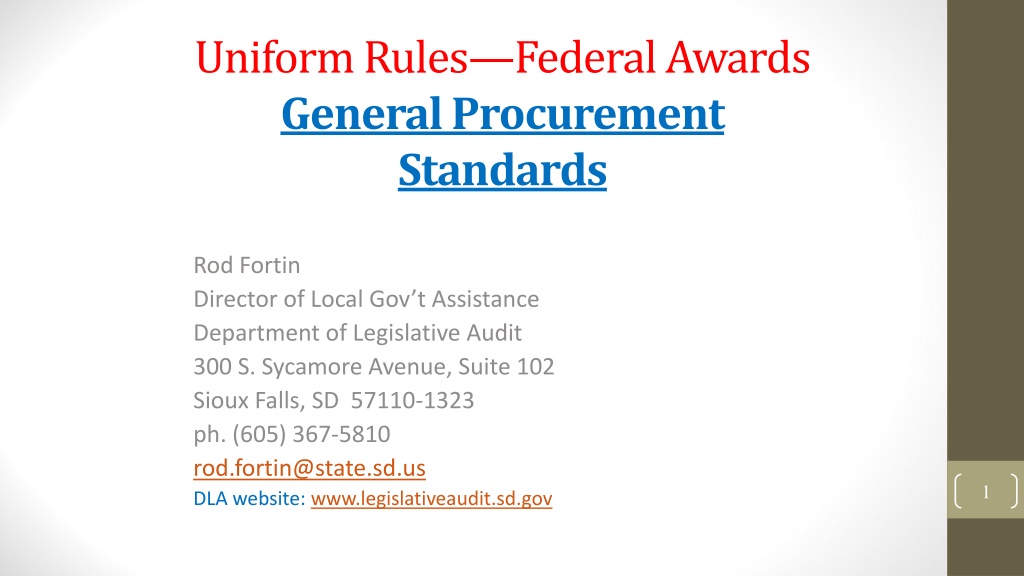



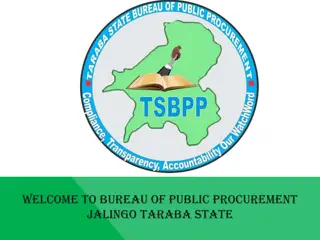

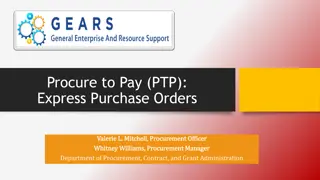
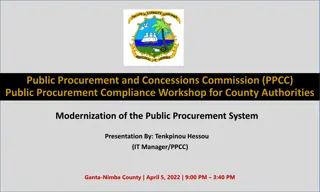
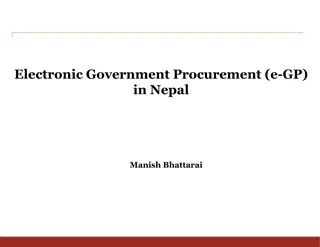
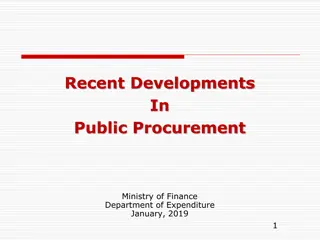
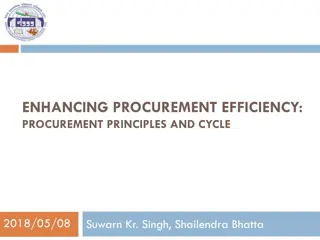
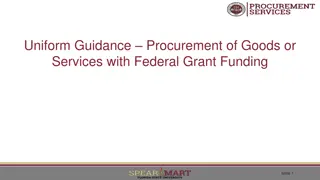

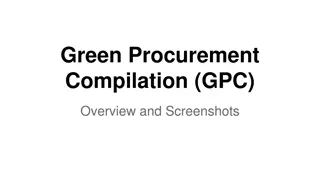
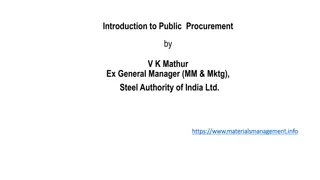
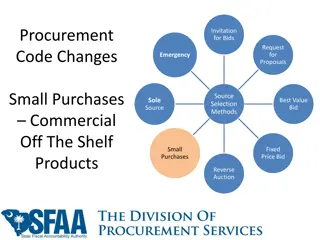
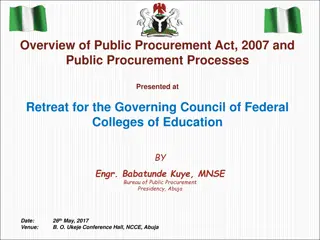
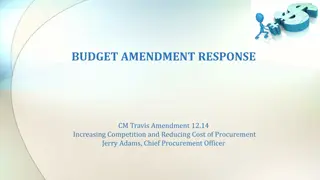
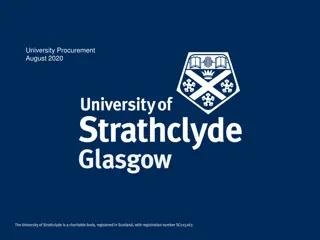
![Comprehensive Overview of Corruption Watch Submission on Public Procurement Bill [B18B-2023]](/thumb/138344/comprehensive-overview-of-corruption-watch-submission-on-public-procurement-bill-b18b-2023.jpg)
